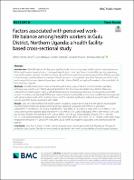| dc.description.abstract | Work-life balance (WLB) plays a significant role in improving career satisfaction and reducing burnout.
While health workers’ productivity is considered a key factor in client care, there is limited effort put into examining
how health workers perceive the balance of their jobs with family and other societal responsibilities (PWLB), especially
in low-income countries where the number of health workers in active patient care is low. The purpose of this study
was to assess factors associated with perceived work-life balance (PWLB) among health workers in the rural district of
Gulu, Northern Uganda.
A health facility-based cross-sectional analytical study was conducted. A simple random sampling
technique was used to select 384 study participants from the three main hospitals in Gulu District. Data were
collected from health workers using a self-administered semi-structured questionnaire and analyzed using STATA
version 15. Factors associated with PWLB were determined at a multivariable level using a modified Poisson regression
with robust variance with a 95% confidence level and 5% statistical significance. Adjusted prevalent ratios (APR) were
used to report the Factors associated with PWLB.
Only 157/384 (40.9%) of the health workers reported a positive perceived work-life balance. Multivariable
modified Poisson regression analysis showed positive statistical association with PWLB of a laboratory
worker(APR=1.74, 95% CI: 1.10–2.75); a midwife(APR=1.82, 95% CI:1.13–2.93) or a nurse (APR=2.19, 95% CI=1.45–
3.30); working in the inpatient department (APR=1.97, 95% CI: 1.31–2.96) or laboratory (APR=2.09, 95%CI: 1.34–3.28);
and having a flexible work schedule (APR=28.32, 95%CI:14.52–55.22); feeling satisfied at work (APR=1.58; 95%
CI:1.17–2.10), and belonging to an association in the community (APR=32.71, 95% Cl:11.91–89.88). On the other hand,
employment tenure of 1–4 years (APR=0.63,95% CI:0.40–0.99) was negatively associated with perceived work-life
balance.
Only four in every 10 health workers experienced a positive perceived work-life balance. The type of
profession, duty station, flexibility in work schedule, satisfaction with work, and availability of social support systems, were independent determinants of perceived WLB. Therefore, nurturing a system of reviews of the scheduling of
health workers, allowing internal staff rotation, and fostering support systems around the health workers could be
beneficial for WLB. | en_US |


